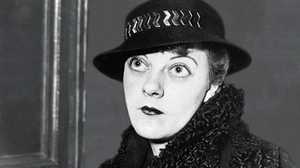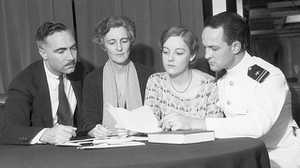Newspaper Coverage of the Massie Affair

"The public was the final jury and the papers the advocates of justice," said defense attorney Clarence Darrow about the trial of his clients Grace Fortescue and Thomas Massie for the so-called "honor killing" of Joseph Kahahawai. After the month-long trial ended with Hawai'i's territorial governor, Lawrence Judd, commuting all four sentences, it was clear that racist press coverage and American public opinion had played an important role in freeing the acknowledged murderers.
Trial by Press
Soon after the alleged assault on Thalia Massie late on the night of September 12, 1931, newspapers had shaped public opinion surrounding the Massie affair. Before mainland papers entered the fray, Hawai'i's two major English language papers, The Honolulu Advertiser and the Honolulu Star-Bulletin, were already at odds with the smaller, ethnic papers, primarily the Japanese language Hawai'i Hochi. The Advertiserran the headline, "GANG ASSAULTS YOUNG WIFE" with the sub-head, "Maltreated By Fiends." Neither the Advertiser nor the Star-Bulletin specifically named Thalia Massie. The Star-Bulletin instead referred to her as "a white woman of refinement and culture." The Hochi, however, named Mrs. Thomas Massie and presented the first evidence that the suspects in custody may not have assaulted Thalia. The papers with primarily haole(white) readership continued to present the case to readers as the police force had -- under the assumption the five suspects were guilty.
Wild Accusations
The mainland press showed little interest in the story until the jury found insufficient evidence to convict the five suspects. The declaration of a mistrial, together with suspect Horace Ida's kidnapping and beating at the hands of Navy men on December 12, 1931 and a Hawai'i Times editorial entitled "The Shame of Honolulu," ignited a firestorm in mainland papers. The papers cited a cable from Navy admiral Yates Stirling proclaiming 40 unpunished rapes in Hawai'i in one year. Neither Stirling nor the journalists attempted to verify this number. The next day, Hawai'i's territorial governor, Lawrence Judd, publicly explained the misleading statistic and denied the accusation of rampant sex crimes. But his words did nothing to quell the sensational storm the newspaper reports created.
Political Motivations
Mainland press reports spurred Congressional demands for an overhaul of the police force and a revision of the Territory of Hawai'i's legislature. The territory's white business and political leaders feared the negative publicity would derail Hawai'i from its track to statehood, and they sought to repair the damage by appeasing the public and, more importantly, satisfying politicians in Washington.
A Call for Vigilante Justice
Unquestionably, the chief of naval operations, Admiral William V. Pratt, made the most damaging statement of all in a cable on December 2, 1931. His words were leaked to the press: "American men will not stand for the violation of their women under any circumstances. For this crime they have taken the matter into their own hands repeatedly when they have felt that the law has failed to do justice." This seeming endorsement of the "unwritten law" or "lynch law" from high levels of the Navy was reported as a matter of fact in mainland papers and by and large went unquestioned. Despite the lack of evidence against him, one of the five suspects, Joe Kahahawai, was kidnapped and killed shortly thereafter, in what would be celebrated as an "honor killing."
Journalists' Dream Story
The Massie case had all the sales-stimulating elements newspapers editors sought: sex, race, politics, an exotic location, a dastardly crime -- and now, a second crime in the name of revenge. William Randolph Hearst's lurid tabloids indelibly branded Kahahawai's murder an honor slaying. The mainland press predicted riots in far-fetched headlines such as "Bayonets Rule Honolulu As Races Boil in Killing."
"Degenerate Natives"
Hearst, who had once said, "you can crush a man with journalism," relished his substantial power to sway public opinion. He wielded it in a January 12 editorial headed, "Martial Law Needed to Make Hawai'i Safe Place for Decent Women." The editorial claimed the roads in Hawai'i "go through jungles and in these remote places bands of degenerate natives lie in wait for white women driving by." The editorial repeated the false claim that there had been 40 rapes in Honolulu in the past year. In the public imagination, Hawaiian natives were linked with lawlessness and sexual danger.
"Beach Boys" Blamed
On the same day, the New York Times printed a story titled "Hawaiian Outbreaks Laid to 'Beach Boys.'" The article, based on Navy interviews, insinuated that the local youth culture, not Thalia's relatives, were ultimately responsible for the death of Joseph Kahahawai.
"Melting Pot of Peril"
Some newspaper accounts bordered on the absurd. A cartoon of half-naked, dark-skinned "natives" grabbing a white woman in a cocktail dress appeared in the February 1 edition of a tabloid called Brevities. An article appeared mirroring Stirling's outspoken assertions that the "melting pot of peril" caused the violence in headlines such as "Race Mixtures Add to Hawai'i's Problems."
Justice Bows to Pressure
The mainland press enthralled the American public with the sensational tale. In April 1932, when the "revenge killers" went to trial, all eyes were on Hawai'i. The case against Thalia Massie's murderous relatives was tried in a very public, political spotlight. Surprisingly, a jury convicted the four defendants. But faced with threats that martial law would be imposed in his territory, Governor Judd bowed to political pressure and commuted each of the four sentences. Thanks in great part to their defense by the American media, the white protagonists in the Massie affair would literally get away with murder.







